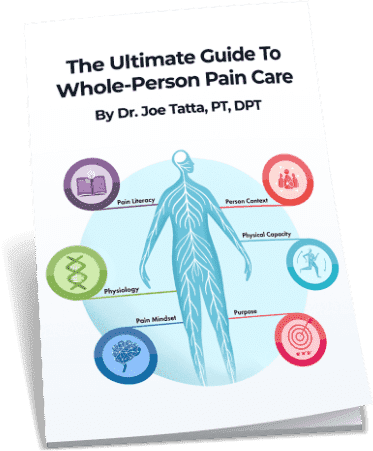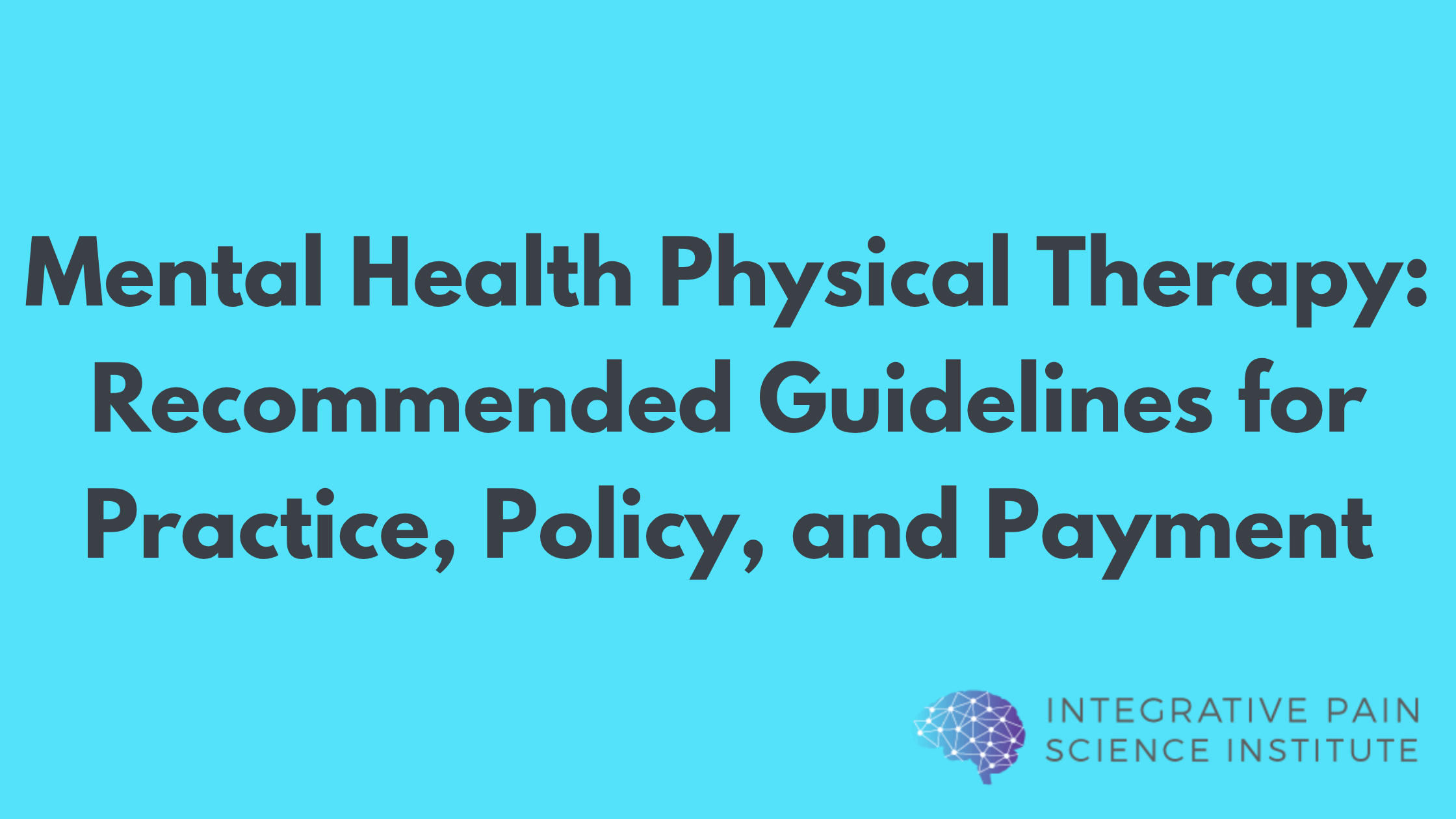The last few decades has seen an explosion of lifestyle-related diseases. Chronic conditions, such as heart disease, diabetes, obesity, and cancer are the leading causes of death and disability. Identifying the root cause of lifestyle conditions is critical to achieve health and wellness. Integrative and Lifestyle Medicine in primary care physical therapy, disease prevention, health promotion, and wellness are in demand.

More than 80% of all health care in the United States is connected to the
treatment of conditions rooted in poor lifestyle choices.(1) The World Health
Organization has called noncommunicable diseases (NCDs) a “slow-motion
disaster.” NCDs kill 41 million people each year, equivalent to 71% of all deaths
globally.(2) Further, NCDs and poor lifestyle choices have a direct impact on
physical therapy outcomes, which underscores the critical need for physical
therapists to understand how to screen for lifestyle factors and intervene using
biopsychosocial, person-centered, integrative care.
As our understanding of Integrative and Lifestyle Medicine continues to grow,
so does the number of people affected by NCDs globally. Physical therapists
are in the unique position to reduce the burden of chronic disease by
counseling their patients or clients about risk factors and the respective
behaviors that promote or aggravate them.
What is Integrative and Lifestyle Medicine?
Conventional medicine, as it stands today, may never solve chronic disease.
The conventional approach confuses the name of the disease with the causes
of the disease. Contrary to popular belief, a “heart attack” is not caused by
“cardiovascular disease.” Cardiovascular disease and the subsequent “heart
attack” is the result of lifestyle factors such as eating foods that provide little
nutritional value, sedentary behaviors that reduce metabolic flexibility, and
poor-quality sleep that impact brain and body homeostatic mechanisms.
Reducing the burden of lifestyle diseases means answering the call quickly with
products, programs, and services for your patients and clients. Can integrative
and lifestyle medicine improve physical therapy outcomes and your practice?
(The answer is yes!)
Integrative and Lifestyle medicine is a biopsychosocial, systems-based,
approach that can be used to treat and reverse the most common lifestyle
conditions including:
- Diabetes
- Obesity
- Stroke
- Cancer
- Chronic pain
- Heart disease
- Osteoporosis
- Endometriosis
- Poor mental health
- Metabolic syndrome
- Polycystic ovarian
syndrome
Lifestyle Medicine is a branch of primary care medicine dealing with the prevention and treatment of disorders caused by lifestyle factors. It includes
6 key precepts:
- Promotion of physical activity
- Plant-based, whole food nutrition
- Sleep, rest and recovery
- Stress reduction
- Avoidance of risky substances
- Positive social connection
A Lifestyle Medicine approach uses whole food, plant-predominant dietary
lifestyle, regular physical activity, restorative sleep, stress management,
avoidance of risky substances and positive social connection as a primary
therapeutic modality for the prevention, treatment, and reversal of chronic
disease. Public health recommendations for lifestyle interventions have been
widely publicized for the treatment and prevention of disease.
Integrative Medicine is a branch of complementary medicine that can be used
as an adjunct to primary care in all branches of health care. The evidence base
supporting Integrative Medicine is robust and growing. Integrative Medicine is
used in combination with conventional medical care, in contrast with alternative
medicine, which is used instead of, or in place of, conventional health care.
According to the National Center for Complementary and Integrative Health,
Integrative Medicine includes practices which can be classified by their primary
therapeutic input (how the therapy is taken in or delivered), which may be:
Nutritional
(e.g., diet, dietary supplements, herbs, probiotics, and microbial-based therapies).
Psychological
(e.g., meditation, hypnosis, music therapies, relaxation therapies).
Physical
(e.g., acupuncture, massage, spinal manipulation).
Combinations
such as psychological and physical (e.g., yoga, tai chi, dance therapies, somatic therapies, some forms of art therapy) or psychological and nutritional (e.g., mindful eating).
The practice of Integrative and Lifestyle Medicine has a powerful impact on modern instigators of chronic pain, chronic disease, and premature disability and death.
Free Download: The Ultimate Guide To Whole-Person Pain Care

The Physical Therapists Role in Integrative and Lifestyle Medicine
Health professionals undergo continuous training throughout their professional
careers. Usually, this consists of updates to their already rigorous training.
Rarely do they have to undergo an extensive recalibration and rethink their
approach to practices which seemed outside their field. In recent years the
discovery of the validity of many complementary and integrative methods led
the American Physical Therapy Association House of Delegates to rethink how
we approach population health, health promotion, and wellness. The House of
Delegates is the APTA policymaking body.(3) They make decisions on issues
that have far-reaching implications for the scope of physical therapy.
The APTA House of Delegates passed a number of critical motions that open
the door to physical therapists using Integrative and Lifestyle Medicine in
practice. The most critical HOD position statements include:
Complementary and integrative interventions hod amended p06‐ 18‐17‐14 [initial: hod p06‐01‐26‐26 [position] (4)
The American Physical Therapy Association supports the continued use of evidence‐based complementary and integrative interventions in physical therapist practice.
The role of the physical therapist in diet and nutrition hod p06-15-22-17 [position] (5)
Diet and nutrition are key components of primary, secondary, and tertiary prevention of many conditions managed by physical therapists. It is the role of the physical therapist to screen for and provide information on diet and nutritional issues to patients, clients, and the community within the scope of physical therapist practice. This includes appropriate referrals to nutrition and dietary medical professionals when the required advice and education lie outside the education level of the physical therapist.
Association’s role in advocacy for prevention, wellness, fitness, health promotion, and management of disease and disability hod p06‐19‐26‐11 [amended: hod p06‐17‐06‐05; hod p06‐16‐ 05‐06; initial: hod p06‐15‐22‐14] [position] (6)
The American Physical Therapy Association (APTA) supports advocacy for prevention, wellness, fitness, health promotion, and management of disease and disability. Advocacy includes but is not limited to, scientific, educational, regulatory, and legislative activities that promote regular physical activity and exercise to enhance health and prevent disease. It includes developing collaborative, interprofessional, and partnering relationships with health service organizations, community organizations, and individuals that advocate for prevention, wellness, fitness, health promotion, management of disease and disability, and efforts that address the social determinants of health.
The role of the physical therapist and the american physical therapy association in behavioral and mental health hod p06-20-40-10 [position] (7)
The American Physical Therapy Association supports interprofessional collaboration at the organizational and individual levels to promote research, education, policy, and practice in behavioral and mental health to enhance the overall health and well-being of society consistent with APTA’s vision. Physical, behavioral, and mental health are inseparably interconnected within overall health and well-being. It is within the professional scope of physical therapist practice to screen for and address behavioral and mental health conditions in patients, clients, and populations. This includes appropriate consultation, referral, or co-management with licensed health services providers in the prevention and management of behavioral and mental health conditions.
Physical therapists as primary care and entry-point providers hod p06-18-28-22 position] (8)
Physical therapists make unique contributions as individuals or members of
primary care teams and are entry-point providers into the healthcare system.
Physical therapists provide a broad range of services to optimize movement,
including screening, examination, evaluation, diagnosis, prognosis, intervention,
coordination of care, prevention, wellness and fitness, and, when indicated,
referral to other providers.
The APTA is a big turning ship.
The two most important HOD motions pertain to the use of evidence
complementary and integrative approaches and physical therapists as primary
care providers. These motions opened doors to future possibility.
Although the APTA HOD motions may be somewhat new, the concept of health
and wellness and how one’s lifestyle impacts health has been around for a long
time. The above changes in physical therapy occurred 5-10 years ago. Like me,
you probably didn’t receive comprehensive training in Integrative or Lifestyle
Medicine in physical therapy school. No structure or standardized approach
was provided for evaluation or treatment. Physical therapists often have
questions about Integrative and Lifestyle Medicine. The most frequent
questions center around:
- “How do you screen for lifestyle-based factors in physical
therapy practice?” - “How do you integrate lifestyle medicine approaches
into practice?’” - “How do you bill successfully: what CPT codes do you use?”
Integrating lifestyle medicine into your practice and successfully billing requires 3 key steps:
Step 1:
Understand the essential health screenings tools so that you can evaluate lifestyle-related conditions.
Step 2:
Choose the optimal lifestyle intervention(s) to support changes to physical health and mental wellbeing.
Step 3:
Know the successful reimbursement methods and practice models.
Case Study: Nutrition and Exercise to Manage and Reverse Diabetes
A 2022 study in the Journal of Orthopedic & Sports Physical Therapy found
that 80% of patients referred to outpatient physical therapy have diabetes or
pre-diabetes. Physical therapists are in an optimal position as front-line primary
care providers to intervene and serve people with diabetes. Diabetes
negatively impacts every tissue responsible for human movement and pain
modulation.
Rupal Patel, PT, PhD is an educator and researcher who focuses on diabetes
care. Her PhD dissertation included a randomized controlled trail in the Journal
of Diabetes Research was on the Effectiveness of a Group-Based Culturally
Tailored Lifestyle Intervention Program on Changes in Risk Factors for Type 2
Diabetes among Asian Indians in the United States. This lifestyle medicine
approach included diabetes education, nutrition, physical activity, and other
non-pharmacologic interventions The data from the investigation are
impressive! Participants achieved significantly lower A1C scores, a biomarker of
long-term glucose control. At 6-months post-intervention many participants
normalized their blood glucose levels and were well on their way to reversing
diabetes. Listen to episode #288 of the Healing Pain Podcast to hear Dr. Patel’s
story of reversing diabetes.
Due to an aging population and continued increase in obesity rates, the
prevalence of diabetes is expected to rise to 592 million by 2035. Diabetes can
lead to several health complications, including cardiovascular disease, stroke,
peripheral arterial disease, nephropathy, neuropathy, retinopathy, lower
extremity amputation, and musculoskeletal impairments. Let us not forget the
emotional and psychological needs of people with diabetes. Dysregulated
blood sugar impacts mood. Eating disorders commonly develop in an attempt
to manage the condition. Many suffer with depression and cognitive decline.
Alzheimer’s is diabetes in the brain.
Diabetes can have devastating effect on the human movement system and lead
to chronic pain. Treating diabetes is about blood sugar control. Lifestyle
medicine is the most evidence-based approach you can take. It is first-line
care. People with diabetes are already in your clinic. This presents an easy
opportunity to intervene and provide lifestyle care. How will you apply this
knowledge to develop services and programs for the people in your clinic?
Would a group-based program be more appropriate for your patient population?
The latest statistics from the Centers for Disease Control found that 38% of
Americans are pre-diabetic. Diabetes and other metabolic health conditions are
driving the trend for lifestyle medicine approaches. Innovation and
opportunities are ripe to help this population.
Diabetes requires a physical therapy intervention.
Chronic pain is also very common among diabetic patients. It causes diabetic
neuropathy and degenerative joint disease. This limits optimal physical function
and routine self-care. Advancing evidence-based lifestyle medicine reverses
non-communicable chronic disease like diabetes. Diabetes is a treatable and
reversible condition yet costs the United States billions of dollars annually for
treatments that slow the progression but fail to address the root cause of
illness. Lifestyle medicine works, and research has shown that this approach
garners a significant return on investment in the treatment of many chronic
conditions.
Trends for Integrative & Lifestyle Medicine in Physical Therapy
McKinsey & Company, a global management consulting firm, estimated the health and wellness market to be $1.5 trillion.(9) This rise in consumer interest and purchasing power presents opportunities across healthcare specialties. Driving the need for lifestyle medicine is poor metabolic health, especially diabetes and obesity. You would be considered metabolically healthy if you had a fasting blood sugar level of 90 mg/dL or lower, and an A1C level below 5.7%, all without using medications.
Integrative and Lifestyle Medicine is a growing field in the physical therapy profession that addresses key health behaviors, which are the root causes of chronic disease, disability, and health care costs. Even though physical therapists are in the ideal position to lead lifestyle interventions an evidence-based resource to guide primary care, health promotion, and disease prevention has been missing. Without a trusted resource we run the risk of being left out of the growing conversation and practice trend in this area.
Integrative and Lifestyle Medicine approaches are also vital in chronic pain management.
Therapeutic lifestyle interventions are a primary modality to treat chronic pain
conditions, and physical therapists are leading primary care and entry-point
providers in chronic pain management. Chronic pain has a tremendous personal
and socioeconomic impact and remains difficult to treat. Understanding
lifestyle factors in people with chronic pain across the lifespan is critical to
physical therapist practice. Lifestyle factors such as physical (in)activity,
sedentary behavior, stress, poor sleep, unhealthy diet, and smoking are
associated with chronic pain intensity and persistence. This applies to all age
groups and chronic pain conditions across the lifespan. Yet current treatment
options often do not or only partly address the many lifestyle factors
associated with chronic pain or attempt to address them in a standard format
rather than providing an individually tailored multimodal lifestyle interventions.
The evidence regarding lifestyle factors is available in adults and older adults
that have chronic pain. More research is needed in this areas as well as in
children and adolescents with pain. Lifestyle most certainly is important in this
population to support a growing brain and body, and for optimal child
development.
Integrative and Lifestyle Medicine aims to eradicate the root cause of disease.
There have been several very significant advances in physical therapy scope of
practice so that we can provide this type of care. Primary care expansion is
changing how we treat, prevent, and manage conditions
Developing an Integrative and Lifestyle Medicine Toolbox
At this point in your career, it probably doesn’t interest you to undergo extensive re-education yet you see the potential dramatic impact this could have on patients. There is a less time-consuming, easier, more
cost-effective way.
Option #1: A NEW textbook on Integrative and Lifestyle Medicine in Physical Therapy
- Nutrition (diet, special diets, supplements)
- Psychology (CBT, ACT, mindfulness, MI)
- Movement (exercise, physical activity, embodiment)
- Biobehavioral (sleep, relaxation, stress reduction)
- Combination approaches that weave together all of the above
You will also learn about the six pillars of lifestyle medicine:
- Diet and nutrition
- Stress management
- Sleep and relaxation
- Physical activity across the lifespan
- Environmental influences on health
- Tobacco cessation, substance use and recovery
In addition, the book delves into social determinants of health and disease;
psychologically informed practice; coaching, counseling and the science of
behavior change, biopsychosocial interventions to promote resilience;
treatment of special populations; and much more!
Chronic disease and pain rates are on the rise globally and are predicted to
accelerate, requiring physical therapists to embrace the role of frontline
primary care practitioner. The physical therapy profession has always led with
non-drug and non-invasive interventions, as well as counseling.
Option #2: Certificate CEU Course in Integrative & Lifestyle Medicine
This 3-hour QuickStart training is designed for immediate clinical application.
You will efficiently learn how to screen and intervene on lifestyle conditions in
clinical practice. The certificate provides a complete toolkit of lifestyle-based
screening tools and patient education handouts. I’ve designed this so that you
can learn big and study small. It even includes best practices for billing, coding,
and increasing ca$h flow. If you want to access a lifestyle-based practice
model with rapid clinical application this course. It is root-cause focused which
addresses many health issues caused by inflammation, poor sleeping, poor
diet, stress and immune imbalances.
Opens your doors to a new patient population. This means new life for your
practice. The training is designed so that you can tailor lifestyle-based
programs for your patients and clients. You will learn:
- The foundations of Integrative & Lifestyle medicine
- How to screen for common lifestyle health risk factors
- Ways to intervene using nutrition, exercise, sleep medicine
- Techniques to reduce stress and optimize social health
- How to bill and code for lifestyle medicine interventions
- Earn 3 CEUs for physical therapists
- How to treat the most common lifestyle conditions
Access a best practice model that will result in the most effective care of your patients and help your practice grow and serve today’s health problems. This course provides a complete toolkit of integrative and lifestyle medicine screening tools and interventions
Feel free to reach out with any question you may have about Integrative Lifestyle Medicine in physical therapy.
Email support@integrativepainscienceinstitute.com

Dr. Joe Tatta, PT, DPT
Dr. Joe Tatta, PT, DPT is the founder of the Integrative Pain Science Institute, a cutting-edge health company reinventing pain care through evidence-based treatment, research, and professional development. His research and career achievements include scalable practice models centered on health behavior change, integrative medicine, and methods that empower physical therapists to serve at the top of their scope of practice as primary providers of healthcare. He is a speaker, author of 3 books, podcast host, and adjunct physical therapy professor. Learn more at integrativepainscienceinstitute.com



